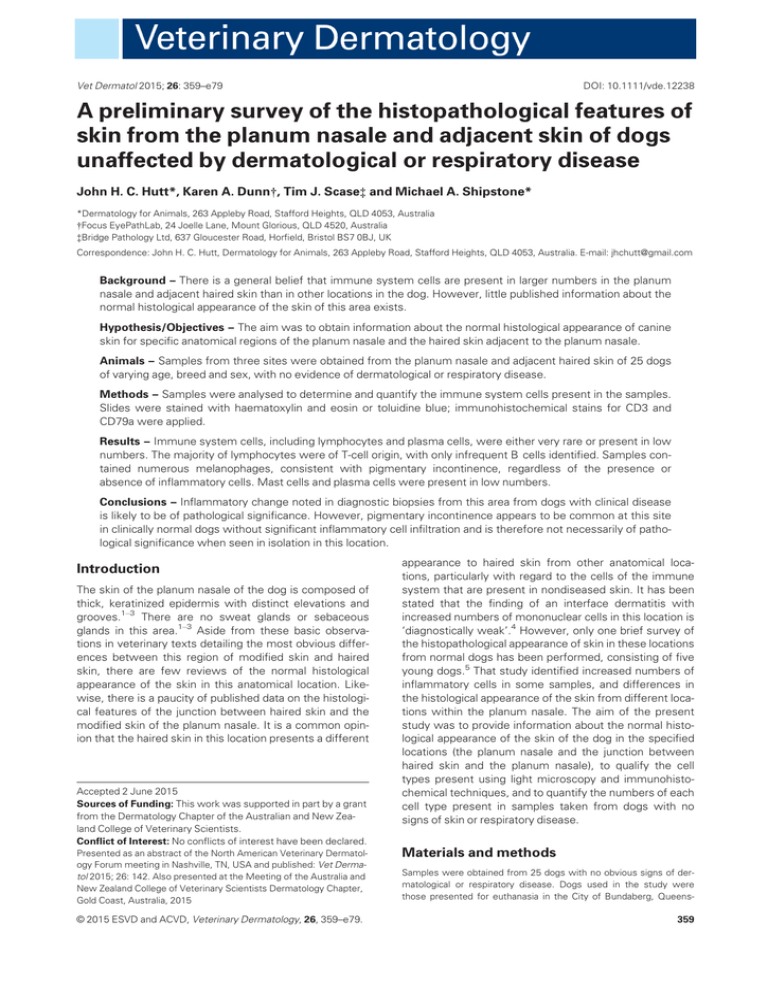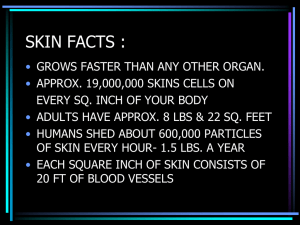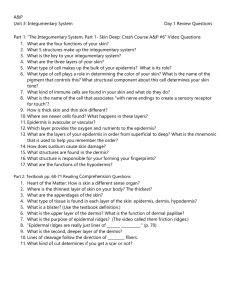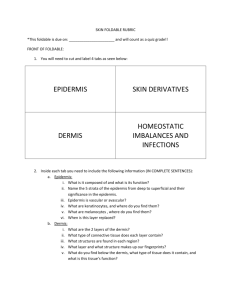A preliminary survey of the histopathological features of
advertisement

Vet Dermatol 2015; 26: 359–e79 DOI: 10.1111/vde.12238 A preliminary survey of the histopathological features of skin from the planum nasale and adjacent skin of dogs unaffected by dermatological or respiratory disease John H. C. Hutt*, Karen A. Dunn†, Tim J. Scase‡ and Michael A. Shipstone* *Dermatology for Animals, 263 Appleby Road, Stafford Heights, QLD 4053, Australia †Focus EyePathLab, 24 Joelle Lane, Mount Glorious, QLD 4520, Australia ‡Bridge Pathology Ltd, 637 Gloucester Road, Horfield, Bristol BS7 0BJ, UK Correspondence: John H. C. Hutt, Dermatology for Animals, 263 Appleby Road, Stafford Heights, QLD 4053, Australia. E-mail: jhchutt@gmail.com Background – There is a general belief that immune system cells are present in larger numbers in the planum nasale and adjacent haired skin than in other locations in the dog. However, little published information about the normal histological appearance of the skin of this area exists. Hypothesis/Objectives – The aim was to obtain information about the normal histological appearance of canine skin for specific anatomical regions of the planum nasale and the haired skin adjacent to the planum nasale. Animals – Samples from three sites were obtained from the planum nasale and adjacent haired skin of 25 dogs of varying age, breed and sex, with no evidence of dermatological or respiratory disease. Methods – Samples were analysed to determine and quantify the immune system cells present in the samples. Slides were stained with haematoxylin and eosin or toluidine blue; immunohistochemical stains for CD3 and CD79a were applied. Results – Immune system cells, including lymphocytes and plasma cells, were either very rare or present in low numbers. The majority of lymphocytes were of T-cell origin, with only infrequent B cells identified. Samples contained numerous melanophages, consistent with pigmentary incontinence, regardless of the presence or absence of inflammatory cells. Mast cells and plasma cells were present in low numbers. Conclusions – Inflammatory change noted in diagnostic biopsies from this area from dogs with clinical disease is likely to be of pathological significance. However, pigmentary incontinence appears to be common at this site in clinically normal dogs without significant inflammatory cell infiltration and is therefore not necessarily of pathological significance when seen in isolation in this location. Introduction The skin of the planum nasale of the dog is composed of thick, keratinized epidermis with distinct elevations and grooves.1–3 There are no sweat glands or sebaceous glands in this area.1–3 Aside from these basic observations in veterinary texts detailing the most obvious differences between this region of modified skin and haired skin, there are few reviews of the normal histological appearance of the skin in this anatomical location. Likewise, there is a paucity of published data on the histological features of the junction between haired skin and the modified skin of the planum nasale. It is a common opinion that the haired skin in this location presents a different Accepted 2 June 2015 Sources of Funding: This work was supported in part by a grant from the Dermatology Chapter of the Australian and New Zealand College of Veterinary Scientists. Conflict of Interest: No conflicts of interest have been declared. Presented as an abstract of the North American Veterinary Dermatology Forum meeting in Nashville, TN, USA and published: Vet Dermatol 2015; 26: 142. Also presented at the Meeting of the Australia and New Zealand College of Veterinary Scientists Dermatology Chapter, Gold Coast, Australia, 2015 © 2015 ESVD and ACVD, Veterinary Dermatology, 26, 359–e79. appearance to haired skin from other anatomical locations, particularly with regard to the cells of the immune system that are present in nondiseased skin. It has been stated that the finding of an interface dermatitis with increased numbers of mononuclear cells in this location is ‘diagnostically weak’.4 However, only one brief survey of the histopathological appearance of skin in these locations from normal dogs has been performed, consisting of five young dogs.5 That study identified increased numbers of inflammatory cells in some samples, and differences in the histological appearance of the skin from different locations within the planum nasale. The aim of the present study was to provide information about the normal histological appearance of the skin of the dog in the specified locations (the planum nasale and the junction between haired skin and the planum nasale), to qualify the cell types present using light microscopy and immunohistochemical techniques, and to quantify the numbers of each cell type present in samples taken from dogs with no signs of skin or respiratory disease. Materials and methods Samples were obtained from 25 dogs with no obvious signs of dermatological or respiratory disease. Dogs used in the study were those presented for euthanasia in the City of Bundaberg, Queens- 359 Hutt et al. land, Australia, following impounding. The dogs ranged in age from 4 to 84 months of age. There were 10 intact females, three neutered females, 10 intact males and two neutered males. Samples were obtained using a 6 mm biopsy punch from predetermined sites immediately following euthanasia with intravenous sodium pentobarbitone. The sites (see Figure 1) were as follows: the junction between haired skin and the planum nasale on the dorsal aspect of the nose (site A); the planum nasale at the edge of the medial side of the left nare (site B); and the midline rostral portion of the planum nasale incorporating the philtrum (site C). Samples were placed in 10% neutral buffered formalin solution for routine tissue fixation. The samples were examined macroscopically by the primary investigator, bisected (samples from the junction of haired skin and planum nasale were bisected so that processed samples would include the junction between the skin types) and submitted in labelled tissue cassettes for processing to paraffin wax. After embedding, 5-lm-thick sections were cut and mounted on glass slides, stained according to previously established protocols6 with haematoxylin and eosin for routine histopathology and, separately, with toluidine blue for mast cells, and coverslipped for examination. Additional 4-lm-thick sections were taken from the paraffinembedded tissues and mounted on positively charged glass slides (Superfrost Plus; Menzel, Braunschweig, Germany) for immunohistochemistry. Sections were dewaxed and heat-mediated antigen retrieval was performed in a Tris/EDTA buffer, pH 9 (Envision FLEX Target Retrieval Solutions; DAKO, Ely, UK) in a computer-controlled heated water bath (PT Link; DAKO) at 97°C for 30 min. Immunohistochemistry was performed using an automated immunohistochemical staining machine (DAKO Cytomation Autostainer Plus). The tissue sections were incubated with the diluted (Envision FLEX antibody diluent; DAKO) primary antibodies for 30 min at room temperature. Antibodies (DAKO) used were CD3 (rabbit polyclonal anti-human CD3) at a dilution of 1:400 and CD79a, clone HM57 (mouse monoclonal anti-human CD79a) at a dilution of 1:400. Endogenous peroxidase activity was blocked by incubation in hydrogen peroxide solution for 30 min (EnVision FLEX peroxidase-blocking reagent; DAKO). Immunohistochemical staining was detected using a goat anti-mouse/rabbit IgG and horseradish peroxidase-tagged polymer system (EnVisionFLEX/HRP; DAKO). Staining was developed with 3,30 -diaminobenzidine tetrahydrochloride (EnVision FLEX DAB+ chromogen; DAKO) and counterstained with haematoxylin. Negative controls were performed by replacing the primary antibody with antibody dilution buffer. Figure 1. Samples were taken using a 6 mm biopsy punch tool from the sites labelled A, B and C. 360 The haematoxylin and eosin and the toluidine blue samples were examined by both the primary and the secondary investigator. The immunohistochemistry samples were examined by both the primary and the tertiary investigator. For each of the three biopsied sites in each case, 10 separate high-power microscopic fields (using 910 magnification eyepieces and a 940 magnification objective lens, corresponding to 9400 magnification, with a calculated field of view 531 lm in diameter) were examined with the aid of a graticule for each of the following four locations: the epidermis, the superficial dermis, the mid-dermis and the deep dermis (see Figure 2). The superficial dermis was defined as the region extending from immediately beneath the epidermis to the upper margin of the sebaceous glands in the sample of junctional haired skin and planum from each individual sampled, and the corresponding level within the planum and philtrum samples from that same individual. The mid-dermis was defined as the region extending from the upper margin of the sebaceous glands to the deepest level containing sebaceous gland lobules in the junctional samples, and at the same level in the corresponding planum and philtrum samples. The deep dermis was defined as the region extending from beneath the sebaceous glands to the subcutis, and the same level in the corresponding planum and philtrum samples for that animal. For each site in every sample, the numbers of polymorphonuclear cells, mast cells, plasma cells, B lymphocytes and T lymphocytes were recorded. In addition, the thickness of the epidermis and the relative thickness, arrangement and features of the stratum corneum in each sample were recorded. Results were collated to provide average cell numbers and average epidermal and keratin thickness for each location. Results Polymorphonuclear cells, plasma cells, B lymphocytes and T lymphocytes were all, on average, present in numbers lower than one cell per high-power field (hpf) in all locations. Mast cells were, on average, present in numbers lower than one cell per hpf in the mid-dermis and the deep dermis. No mast cells were identified in the epidermis in any field in any sample. Mast cells were, on aver- Figure 2. Cells were counted in the skin at 10 randomly selected high-power fields in each of the sites labelled in the figure as follows: DD, deep dermis; E, epidermis; MD, mid-dermis; and SD, superficial dermis. © 2015 ESVD and ACVD, Veterinary Dermatology, 26, 359–e79. Dog planum nasale histology survey age, present at a rate slightly higher than one cell per hpf (1.2253 per hpf) in the superficial dermis. Epidermal layers consisisted of stratum basale, stratum spinosum and, rarely, stratum granulosum; the stratum granulosum was generally seen only in the junctional haired skin and the stratum corneum. The stratum corneum in the nasal planum samples was invariably compact and generally orthokeratotic in nature; however, nine cases showed some focal areas of parakeratosis in the absence of inflammation. Where the epidermis was heavily pigmented, the stratum corneum was generally also heavily pigmented. The thickness of the stratum corneum ranged from an average of 3.44 lm in haired skin to an average of 9.4 lm in nonhaired skin. The thickness of the epidermis ranged from 4.9 to 16.5 cells (averaged over 10 hpf). This equated to an average epidermal thickness of 5.96 lm in haired skin and 14.26 lm in nonhaired skin, not including rete. Epidermal rete in the nasal planum samples were often irregular in shape and size, but in general tended to reach approximately uniform depth across the sample (see Figure 3). Epidermal pigmentation ranged from absent through negligible or light to very dark. The pigmentation was also variably confined to the basal layer or spread diffusely throughout the epidermis; however, the majority of cases showed full-thickness pigmentation. Pigment tended to be most marked in the tips of the epidermal rete. Where pigmentation was not diffuse throughout the epidermis, there was occasionally full-thickness pigmentation of the epidermis focally overlying rete. One or two cases showed clumped pigmentation of the basal epidermis, with very darkly pigmented cells present, similar to what is seen in normal colour-dilute epidermis of haired skin. All samples contained variable numbers of melanophages and, less commonly, free melanin granules within the superficial dermis, consistent with pigmentary incontinence, generally in the absence of observable inflammation (see Figure 4). Mast cells showed close association with the epidermis in the nonhaired skin of the nasal planum. Figure 3. Nasal planum sample: epidermis and superficial dermis showing parakeratotic hyperkeratosis and rete ridge formation (nonhaired skin). © 2015 ESVD and ACVD, Veterinary Dermatology, 26, 359–e79. Polymorphonuclear cells were present in extremely low numbers in most samples; the majority of those seen were neutrophils. Neutrophils were found in moderate numbers in only one sample. Eosinophils were found as solitary cells in only two samples. See Table S1 in Supporting information for cell counts and measurements. Discussion To the best of the authors’ knowledge, there are no systematic surveys of the histopathology of clinically normal dog skin from any location. However, most histopathology textbooks and atlases contain photographic figures and descriptions of the normal histopathological appearance of haired dog skin and the skin of the planum nasale. In this survey, we have identified a number of key differences as well as similarities to what is widely accepted as normal. The key differences from haired skin involved the increased thickness of the epidermis and the stratum corneum, and these changes would appear to be in line with previous observations. The age, breed and sex of the dogs did not appear to have an impact on any of the findings. In contrast to widely accepted opinion, cells of the immune system do not appear to be present in large numbers in the clinically normal nasal planum and adjacent junctional skin. There was no evidence of lichenoid inflammation or obscuring of the dermo-epidermal junction by cellular infiltrates in any sample. Immune system cells, including lymphocytes and plasma cells, were present, but were either very rare or seen only in low numbers. The presence of these cells may represent lowgrade antigenic stimulation in an anatomical location that interacts closely with the environment. Polymorphonuclear cells were present in extremely low numbers in most samples; the majority of those seen were neutrophils, with very rare single eosinophils seen in isolated cases. Neutrophils were found in moderate numbers in only one sample, in the mid- and deep dermis. As this case was such an outlier, it is possible that this individual had sustained a recent injury or microbial infection that Figure 4. Detail of pigmentary incontinence in the superficial dermis. 361 Hutt et al. was resolving and therefore inapparent at the time of sampling. Of note was that samples all contained variable numbers of melanophages and, less commonly, free melanin granules, within the superficial dermis, consistent with pigmentary incontinence, generally in the absence of observable inflammation at this location. Pigmentary incontinence is often regarded as a sign of immune-mediated damage to the epidermal melanin unit (such as in lichenoid interface dermatoses), but may also be associated with physical injury or trauma to the epidermis, particularly the basal epidermis.7 It may also be associated with spillover of pigment into the dermis from a hyperpigmented epidermis, which may be associated with a variety of causes, including nonspecific local inflammation. Clinically, it is associated with alterations in visible pigmentation;7 both epidermal hyperpigmentation and, less commonly, hypopigmentation may be seen clinically in association with this histological finding.7 The finding of pigmentary incontinence in the skin of normal dogs and without evidence of significant associated inflammation or true interface change is interesting and challenges the most commonly accepted interpretation of this finding, and may also be responsible for the overdiagnosis of immune-mediated disease at this site due to overinterpretation of background ‘normal’ melanophage infiltration in the nasal planum. Given the almost universal presence of this finding across all the samples examined, it is thought that chronic low-grade injury at this site as a ‘normal’ occurrence gives rise to the finding. In conclusion, immune system cells are not present in large numbers in this anatomical location in clinically normal dogs. Inflammatory change noted in biopsies from this area is therefore likely to be of pathological significance. However, pigmentary incontinence appears to be common at this site and is therefore not necessarily of pathological significance when seen in isolation in this location. Age, breed and sex do not appear to affect the histological appearance of the skin in this location. Further studies to qualify and quantify other cell types (melanocytes, Langerhan’s cells) are required to provide a further evidence base for the normal histological appearance of the skin in both this and other anatomical locations in the dog. References 1. Monteiro-Riviere NA, Stinson AW, Calhoun HL. Integument. In: Dellmann H-D, ed. Textbook of Veterinary Histology, 4th edition. Philadelphia, PA: Lea & Febiger, 1993; 301. 2. Bacha WJ, Bacha LM. Integument. In: Bacha WJ, Bacha LM, eds. Color Atlas of Veterinary Histology, 2nd edition. Philadelphia, PA: Lippincott Williams & Wilkins, 2000; 85–118. 3. Yager JA, Wilcock BP. How to get started. In: Color Atlas and Text of Surgical Pathology of the Dog and Cat. Dermatopathology and Skin Tumors. London: Wolfe; 1994:11–14. 4. Shearer DH. Dermatopathology. In Jackson HA, Marsella R, eds. BSAVA Manual of Canine and Feline Dermatology, 3rd edition. Gloucester: BSAVA, 2012; 31–36. 5. Bettenay SV, Mueller RS. Histologic features of the normal canine nose. In: Proceedings of the Annual Meeting of the Australasian College of Veterinary Scientists Dermatology Chapter. Gold Coast: 2003. 6. Feldman AT, Wolfe D. Tissue processing and hematoxylin and eosin staining. In: Day CE, ed. Histopathology Methods and Protocols. New York: Humana, 2014; 31–43. 7. Yager JA, Wilcock BP. General reactions of the skin to injury. In: Color Atlas and Text of Surgical Pathology of the Dog and Cat. Dermatopathology and Skin Tumors. London: Wolfe, 1994; 15– 38. Supporting Information Additional Supporting Information may be found in the online version of this article. Table S1. Cell counts and measurements. sume Re ne ralement admis que les cellules du syste me immunitaire sont pre sentes en plus Contexte – Il est ge grand nombre dans le planum nasal et la peau velue adjacente chez le chien. Cependant, peu de publications existent sur l’apparence histologique normale de la peau de cette zone. Objectifs – Obtenir des informations sur l’apparence histologique normale de la peau de chien pour les gions anatomiques spe cifiques du planum nasal et de la peau velue adjacente. re chantillons de trois sites ont e te obtenus sur le planum nasal et la peau velue adjacente de Sujets – Des e rents, sans maladie apparente cutane e ou respiratoire. 25 chiens d’^age, de race et de genre diffe thodes – Les e chantillons ont e te analyse s pour de terminer et quantifier les cellules immunitaires Me sentes dans les pre le vements. Les lames ont e te colore es malun-e osine et au bleu de toluidine; pre a l’he te applique es. les colorations immunohistochimiques pour CD3 et CD79 ont e sultats – Les cellules immunitaires, y compris les lymphocytes et les plasmocytes, e taient soit tre s Re sentes en faible nombre. La majorite des lymphocytes e taient d’origine T avec des cellules B rares soit pre es seulement rarement. Les e chantillons contenaient de nombreux me lanophages correspondant identifie a de l’incontinence pigmentaire sans lien avec la pre sence ou l’absence de cellules inflammatoires. Les taient pre sents en faible nombre. mastocytes et plasmocytes e dans les biopsies de cette zone de chiens Conclusions – Tout changement inflammatoire, remarque sentant des le sions cliniques, doit e ^tre conside re comme pathologique. Cependant l’incontinence pigpre ^tre fre quente sur cette zone, chez les chiens cliniquement sains sans infiltrat cellulaire mentaire semble e cessairement pathologique quand observe isolement dans inflammatoire significatif et n’est donc pas ne gion. cette re 362 © 2015 ESVD and ACVD, Veterinary Dermatology, 26, 359–e79. Dog planum nasale histology survey Resumen n – hay una creencia generalizada que las ce lulas del sistema inmune est Introduccio an presentes en gran n cantidad en el plano nasal y en la piel adyacente en el perro. Sin embargo, se ha publicado poca informacio acerca de la apariencia histologica normal de la piel en esta area. n acerca de la apariencia histolo gica normal de la piel canina en regiones Objetivos – obtener informacio micas especıficas del plano nasal y de la piel adyacente al plano nasal. anato Animales – muestras de tres localizaciones obtenidas del plano nasal y de la piel adyacente en 25 perros de diversa edad, raza y sexo sin evidencia de enfermedades de la piel ni respiratorias. todos – se analizaron muestras para determinar y cuantificar las ce lulas del sistema inmunitario presenMe ~idas con hematoxilina-eosina, azul de toluidina, e inmunotes en las muestras. Las preparaciones fueron ten histoquımica para CD3 y CD79a. lulas del sistema inmunitarios incluidos linfocitos y ce lulas plasm Resultados – Las ce aticas fueron muy lo infremero. La mayorıa de los linfocitos fueron de origen T, con so raras o presentes en muy bajo nu lulas de origen B identificadas. Las muestras contenıan numerosas melano fagos, consistente cuentes ce lulas inflamatorias. Los mastocitos y con incontinencia pigmentarıa, independiente de la presencia de ce mero plasmaticas estaban presentes en bajo nu stica de esta Conclusiones e importancia clınica – un cambio inflamatorio apreciado en biopsia diagno gica. Sin embargo la incontizona en perros con enfermedad clınica seguramente tenga relevancia patolo n en perros clınicamente normales sin un nu n en esta localizacio mero nencia pigmentarıa parece ser comu lulas inflamatorias y por tanto no es necesariamente un hallazgo patolo gico significativo significante de ce n. cuando se ve aislado en esta localizacio Zusammenfassung €ßeren Zahlen im Hintergrund – Es wird generell angenommen, dass die Zellen des Immunsystems in gro Planum nasale und der angrenzenden Haut des Hundes vorkommen. Es gibt jedoch wenig publizierte Infor€rperregion. €ber das normale histologische Erscheinungsbild dieser Ko mation u €ber das normale histologische Erscheinungsbild der Hundehaut in Ziele – Information zu gewinnen u €rperregionen wie dem Planum nasale und der behaarten Haut, die an das Planum nasale speziellen Ko angrenzt. Tiere – Es wurden Proben von drei Stellen am Planum nasale und der angrenzenden behaarten Haut von 25 Hunden unterschiedlichen Alters, Rasse und Geschlecht, ohne einer dermatologischen oder respiratorischen Erkrankung genommen. Methoden – Es wurden Proben analysiert, um die Zellen des Immunsystems in diesen Zellen zu bestimmen und zu quantifizieren. Die Schnitte wurden mit H€ amatoxylin und Eosin, sowie mit Toluidinblau €r CD3 und CD79a verwendet. angef€arbt; es wurden immunhistochemische F€ arbungen fu €ren waren entweder Ergebnisse – Die Immunzellen, zu denen die Lymphozyten und Plasmazellen geho sehr selten oder nur in sehr geringer Anzahl vorhanden. Die Mehrzahl der Lymphozyten entsprangen den T-Zellen, wobei nur wenige B-Zellen identifiziert werden konnten. Die Proben enthielten zahlreiche €ndungszellen Melanophagen, die mit einer Pigmentinkontinenz im Zusammenhang standen, egal ob Entzu vorhanden waren oder nicht. Mastzellen und Plasmazellen waren in einer geringen Anzahl vorhanden. €rperstellen €ndliche Ver€ Schlussfolgerungen – Entzu anderungen, die in diagnostischen Biopsien dieser Ko bei Hunden mit klinischer Erkrankung vorkommen, sind wahrscheinlich von pathologischer Bedeutung. Nichtsdestotrotz scheint Pigmentinkontinenz an diesen Stellen auch bei klinisch gesunden Hunden ohne €ndungszellinfiltration h€aufig aufzutreten und ist daher nicht unbedingt von pathologischer signifikante Entzu Bedeutung, wenn es an diesen Stellen isoliert auftritt. 要約 背景 – イヌにおいて、鼻鏡と隣接した有毛部皮膚に数多くの免疫細胞が存在するという通説がある。しかし、その領域 の皮膚の正常な組織学的な所見に関する論文化された情報はほとんどない。 目的 – 鼻鏡および鼻鏡に隣接した有毛部皮膚の特殊な解剖学的部位における、イヌの皮膚の正常な組織学的所見 に関する情報を得ること。 供与動物 – 皮膚あるいは呼吸器疾患のない様々な年齢、犬種、性別の25頭のイヌの鼻鏡および隣接した有毛部か ら材料を採取した。 方法 – 材料内に存在する免疫細胞を決定し、定量するために解析を行った。標本をヘマトキシリンとエオジン、およびト ルイジンブルーで染色し、CD3およびCD79aを染める免疫組織科学染色をおこなった。 結果 – リンパ球および形質細胞を含む免疫細胞は非常に少ないか、少数のみ見られた。大部分のリンパ球はT細胞 由来で、B細胞はまれにしか認められなかった。材料には炎症細胞の存在の有無にかかわらず、色素失調と一致する 多数のメラノファージが含まれていた。肥満細胞および形質細胞は少数存在していた。 結論 – 臨床的に疾患を示すイヌの、この領域からの診断のための生検において認められた炎症性変化は病理学的な 重要性を示している可能性がある。しかし、色素失調はこの部位では 有意な炎症細胞がみられない臨床的に正常なイ ヌにおいても一般的に生じ、それゆえにこの部位において単独で認められても必ずしも病理学的な重要性はない。 © 2015 ESVD and ACVD, Veterinary Dermatology, 26, 359–e79. e78 Hutt et al. 摘要 背景 – 现普遍认为,犬的鼻面和其相邻的有毛皮肤上存在大量的免疫系统细胞。然而,很少有关于此位置皮 肤正常组织学特点的报道。 目的 – 获得正常犬鼻面及相邻有毛皮肤,这些特殊的解剖位点的正常组织学信息。 动物 – 选不同年龄、品种、性别的25只犬,且没有明显皮肤或呼吸道疾病,取其鼻面以及相邻皮肤的三处样 本。 方法 – 分析样本,确定和量化样本中出现的免疫系统细胞。切片使用苏木精和曙红,以及甲苯胺蓝染色;免疫 组化染色用CD3 和 CD79a抗体。 结果 – 免疫系统细胞包括淋巴细胞和浆细胞,两者均非常罕见并数量极少。大多数淋巴细胞源自T细胞,只辨 认出极少量B细胞。样本无论是否有炎性细胞,都包含很多噬黑素细胞,色素失禁。肥大细胞和浆细胞数量较 少。 结论 – 有临床症状的患犬,这个区域的活检出现炎性改变可能有病理学意义。然而,色素失禁常出现于该位 点,无临床表现的犬并无明显炎性细胞浸润,因此在这个区域单独出现色素失禁未必有病理学意义。 e79 © 2015 ESVD and ACVD, Veterinary Dermatology, 26, 359–e79.







